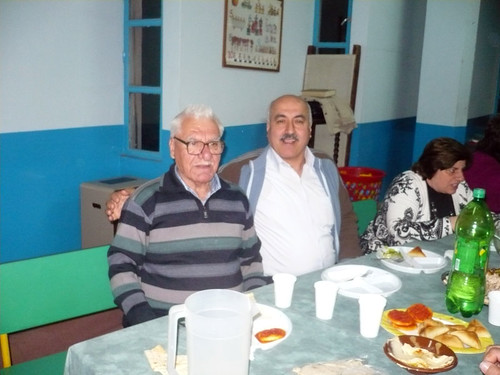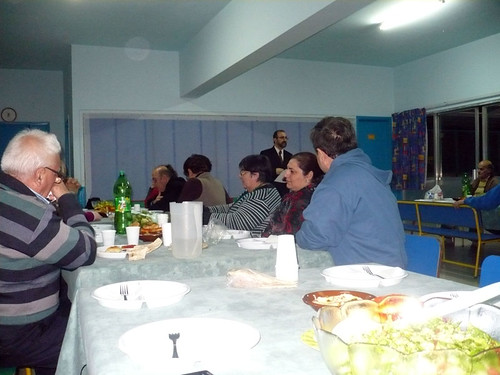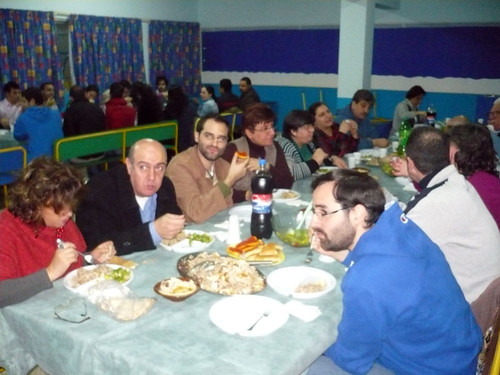Միահամուռ Քայլերով Ընթացք
Screening of “Ravished Armenia” in Commemoration of the Armenian Genocide
On Saturday, April 30, the Lebanese public had a unique opportunity to watch the first Armenian Genocide film “Ravished Armenia” that was produced in 1919. The Armenian Evangelical Cultural Association (AECA) organized a special evening to commemorate the 96th anniversary of the Armenian Genocide. The event took place at the First Armenian Evangelical Church in Beirut.
The program began with the opening word of the chairperson of the AECA Miss Shushan Artinian, who noted that the evening was a special tribute to all the survivors of the Genocide perpetrated by the Ottoman government, and especially to Arshalouys ‘Aurora’ Mardiganian, a witness and survivor during the first World War. She then introduced the guest speaker, Miss Katia Peltekian, currently a faculty member at Haigazian University, who spends her time researching for old archival material related to the Genocide, her main interest being compiling newspaper reports and articles of the late 19th century and early 20th century.
The evening’s program began with poetry recital. Sero Kelougian recited Siamanto’s “I Want To Die Singing” and was accompanied with duduk melody performed by his father Hagop Kelougian. Then Miss Peltekian took the podium and introduced the film “Ravished Armenia.” Her presentation included information about the making of the movie at the end of 1918 in Hollywood, including information about the producer, the director, and the cast which included Arshalouys herself and Mr. Henry Morgenthua, US Ambassador to Turkey at the time. Miss Peltekian then showed a few ads she had collected from different newspapers of the time promoting the film in different cities of the USA, Canada, and Britain. The ads specifically indicated that the purpose of the movie was to raise $30 million to help the orphans that had survived the massacres during 1915-16. One interesting news item came from Great Britain, where the League of Nations Union wanted to screen the movie at the Royal Albert Hall; political intrigue from the Foreign office resulted in censoring by the Scotland Yard and the Home Office five scenes from the movie in order not to raise any anti-Turkish sentiments as the Peace Conference with Turkey was still going on. The censoring of crucial scenes was implemented, and the word “Christian” was erased from all subtitles before it was given permission to be shown to the public.
Afterwards, Miss Peltekian related the story of 14-year-old Arshalouys Mardiganian, who had witnessed not only the murder of every single member of her family on the deportation route, but also the daily sufferings and mass murders of her fellow-Armenians. In fact, Arshalouys was also abducted and sold to Turkish pashas and beys for their harems. She escaped the two-year ordeal and was finally saved by an American missionary in Erzuroum and brought to New York with the help of the American Committee for Armenian and Syrian Relief.
The audience then watched the movie. The original movie was 85 minutes long, but it is considered lost. However, a 20-minute segment was discovered a couple of decades ago and is now reserved at the Genocide Museum in Yerevan. The nitrate based film was newly restored and produced by the late Richard Kloian from the Armenian Genocide Resource Center of
Northern California. The audience, some with tears in their eyes, watched the excruciatingly disturbing and stirring scenes that depicted every single crime that constitutes Genocide.
After the movie, Miss Peltekian described the last days of Arshalouys Mardiganian, who had married in 1929 and had a son. However, although she had lived and survived the worst atrocity in the history of mankind, her life ended in more tragedy as she died alone and her body was not claimed by anyone, not even her son. Her ashes were buried with around 2100 other unclaimed ashes of those who had passed away in 1994. Arshalouys did not even have a gravestone with her name carved on it.
At the end of the evening’s program, the Arakelots’ Chamber Choir, conducted by Krikor Alozian and accompanied by Hasmig Kasbarian on the piano, performed Mesrob Mashdots’ “I Stand Before Thee” and “ Have Mercy on Me, Oh Lord!” and Magar Yegmalian’s “Holy Holy.”
The evening was concluded by Pastor Hrayr Cholakian.
Press Release
Armenian Evangelical Cultural Association
The First Armenian Evangelical Church
Mexique Street, 11-2508
Riyad El Solh, Beirut 1107-2110, Lebanon Email: aecahamm@yahoo.com
May 1, 2011
The program began with the opening word of the chairperson of the AECA Miss Shushan Artinian, who noted that the evening was a special tribute to all the survivors of the Genocide perpetrated by the Ottoman government, and especially to Arshalouys ‘Aurora’ Mardiganian, a witness and survivor during the first World War. She then introduced the guest speaker, Miss Katia Peltekian, currently a faculty member at Haigazian University, who spends her time researching for old archival material related to the Genocide, her main interest being compiling newspaper reports and articles of the late 19th century and early 20th century.
The evening’s program began with poetry recital. Sero Kelougian recited Siamanto’s “I Want To Die Singing” and was accompanied with duduk melody performed by his father Hagop Kelougian. Then Miss Peltekian took the podium and introduced the film “Ravished Armenia.” Her presentation included information about the making of the movie at the end of 1918 in Hollywood, including information about the producer, the director, and the cast which included Arshalouys herself and Mr. Henry Morgenthua, US Ambassador to Turkey at the time. Miss Peltekian then showed a few ads she had collected from different newspapers of the time promoting the film in different cities of the USA, Canada, and Britain. The ads specifically indicated that the purpose of the movie was to raise $30 million to help the orphans that had survived the massacres during 1915-16. One interesting news item came from Great Britain, where the League of Nations Union wanted to screen the movie at the Royal Albert Hall; political intrigue from the Foreign office resulted in censoring by the Scotland Yard and the Home Office five scenes from the movie in order not to raise any anti-Turkish sentiments as the Peace Conference with Turkey was still going on. The censoring of crucial scenes was implemented, and the word “Christian” was erased from all subtitles before it was given permission to be shown to the public.
Afterwards, Miss Peltekian related the story of 14-year-old Arshalouys Mardiganian, who had witnessed not only the murder of every single member of her family on the deportation route, but also the daily sufferings and mass murders of her fellow-Armenians. In fact, Arshalouys was also abducted and sold to Turkish pashas and beys for their harems. She escaped the two-year ordeal and was finally saved by an American missionary in Erzuroum and brought to New York with the help of the American Committee for Armenian and Syrian Relief.
The audience then watched the movie. The original movie was 85 minutes long, but it is considered lost. However, a 20-minute segment was discovered a couple of decades ago and is now reserved at the Genocide Museum in Yerevan. The nitrate based film was newly restored and produced by the late Richard Kloian from the Armenian Genocide Resource Center of
Northern California. The audience, some with tears in their eyes, watched the excruciatingly disturbing and stirring scenes that depicted every single crime that constitutes Genocide.
After the movie, Miss Peltekian described the last days of Arshalouys Mardiganian, who had married in 1929 and had a son. However, although she had lived and survived the worst atrocity in the history of mankind, her life ended in more tragedy as she died alone and her body was not claimed by anyone, not even her son. Her ashes were buried with around 2100 other unclaimed ashes of those who had passed away in 1994. Arshalouys did not even have a gravestone with her name carved on it.
At the end of the evening’s program, the Arakelots’ Chamber Choir, conducted by Krikor Alozian and accompanied by Hasmig Kasbarian on the piano, performed Mesrob Mashdots’ “I Stand Before Thee” and “ Have Mercy on Me, Oh Lord!” and Magar Yegmalian’s “Holy Holy.”
The evening was concluded by Pastor Hrayr Cholakian.
Press Release
Armenian Evangelical Cultural Association
The First Armenian Evangelical Church
Mexique Street, 11-2508
Riyad El Solh, Beirut 1107-2110, Lebanon Email: aecahamm@yahoo.com
May 1, 2011
Appreciation Dinner for All those Serving in the Armenian Evangelical Emmanuel Church
On Saturday, 2 April - the Hokapartsoutyoun organized an appreciation dinner for all the members serving in the committees and all the ladies, men, youth, and teenagers, who devote their time and talent for the mission and vision of His church.
Around 40 people who serve in various committes (Hokapartsoutyoun, Khnamagaloutyoun, Sunday School, Badaniatz, Chanitz, Ladies Committee, Young Couples, Church Band, Chanitz Blog) gathered in the Kindergarten Hall of the Armenian Evangelical Torosian School.
The pastor, Rev. Svajian, shared a devotion with the following theme: Serve the Lord (Romans: 12.11) and thanked all the volunteers and prayed for them. After the prayer and dinner, the members shared about their committees and their plans.








Around 40 people who serve in various committes (Hokapartsoutyoun, Khnamagaloutyoun, Sunday School, Badaniatz, Chanitz, Ladies Committee, Young Couples, Church Band, Chanitz Blog) gathered in the Kindergarten Hall of the Armenian Evangelical Torosian School.
The pastor, Rev. Svajian, shared a devotion with the following theme: Serve the Lord (Romans: 12.11) and thanked all the volunteers and prayed for them. After the prayer and dinner, the members shared about their committees and their plans.








Mothers' Day in the Armenian Evangelical Secondary School of Anjar
THE END?
Jesus’ return is imminent, but does that mean it will happen this month?
The predictions are proclaimed everywhere—on billboards, lawn signs, placards held by groups of people at intersections. The message is clear: the day is almost here when Jesus will return to judge the world. The call is to all people to repent and believe in Jesus Christ in order to be taken away at the rapture of all true believers…to occur on an exact date. The messenger is a self-educated Bible teacher, who has amassed numerous followers through his radio and television outreach with claims to possess the proper understanding of the secrets of God, hidden through the ages–secrets which even Jesus himself did not claim to know, if we are to believe his cautionary words in Matt. 24:36, 44.
As Christians, in order to derive some benefit from this situation, and perhaps even deepen our faith roots so that we are not “blown about by every wind of doctrine” (Eph. 4:14), we should review a number of things, but do so “speaking the truth in love” (Eph. 4:15).
First of all, Christ did in fact promise to return (see Matt. 25.31-46 and others) in judgment. This word to the early church was central to the first believers’ preaching and the vitality of their outreach as well as their compassion. We preachers have found it convenient to excise that aspect of Christ’s teachings from our sermons, and too many churches have been satisfied to settle for this. But for a lasting transformation of a world permeated with selfishness and evil, the only lasting hope is the
Coming of the Lord.
Second, it is a fruitless and naïve endeavor to claim to know the date and time. Making predictions has always been a failure (if you are interested, look up “October 22, 1844” to learn why this is so), and has brought ridicule not just upon those making this claim, but on the gospel itself as being merely a fantasy. Jesus told us to be watchful and faithful stewards and servants until that unexpected hour; he did not tell us to spend time counting the hours until it happened.
Third, sincerity of belief is no guarantee of being correct. Even people of other faiths might be much more convinced that they have the correct revelation, and even be willing to die (or kill) for that conviction, but that does not prove that they are “of the truth.” God’s truth, taught to us in the scriptures and embodied in Jesus Christ, makes it clear that we must be humbly following our Lord in order to be “in the truth.”
Fourth, the truth we are called to proclaim in this world is much more powerful and more winsome than any sort of date-setting. We are entrusted with the gospel of grace, offering the words of hope in Jesus Christ that people long for, words which bring new life and transformation where previously there had been only dead ends and decay. Christ’s people must reiterate the Lord’s call to repentance, admitting, “all have sinned and fall short of the glory of God” (including themselves), while never neglecting to add that God accepts all who trust in Jesus and not in their own righteousness (see Romans 3:21-26).
When we speak the truth in love, let us be mindful of people’s anxiety about “Judgment Day” and “End of the World” predictions, especially at a time when wars and unrest, economic struggles and natural disasters seem to corroborate the predictions of some. Jesus our Savior must be our example
in this. He both rigorously challenged the religious teachers caught up in the certainty of their systems and half-truths, while at the same time tenderly binding the wounds of the brokenhearted and calling them to turn from their sin to follow him while they still had the opportunity to do so. May Jesus’ wisdom, power and love be our inspiration and our guide.
In Christ’s love,
Badveli Nishan Bakalian
ARMENIAN MARTYRS’ CONGREGATIONAL CHURCH OF PHILADELPHIA, USA

The predictions are proclaimed everywhere—on billboards, lawn signs, placards held by groups of people at intersections. The message is clear: the day is almost here when Jesus will return to judge the world. The call is to all people to repent and believe in Jesus Christ in order to be taken away at the rapture of all true believers…to occur on an exact date. The messenger is a self-educated Bible teacher, who has amassed numerous followers through his radio and television outreach with claims to possess the proper understanding of the secrets of God, hidden through the ages–secrets which even Jesus himself did not claim to know, if we are to believe his cautionary words in Matt. 24:36, 44.
As Christians, in order to derive some benefit from this situation, and perhaps even deepen our faith roots so that we are not “blown about by every wind of doctrine” (Eph. 4:14), we should review a number of things, but do so “speaking the truth in love” (Eph. 4:15).
First of all, Christ did in fact promise to return (see Matt. 25.31-46 and others) in judgment. This word to the early church was central to the first believers’ preaching and the vitality of their outreach as well as their compassion. We preachers have found it convenient to excise that aspect of Christ’s teachings from our sermons, and too many churches have been satisfied to settle for this. But for a lasting transformation of a world permeated with selfishness and evil, the only lasting hope is the
Coming of the Lord.
Second, it is a fruitless and naïve endeavor to claim to know the date and time. Making predictions has always been a failure (if you are interested, look up “October 22, 1844” to learn why this is so), and has brought ridicule not just upon those making this claim, but on the gospel itself as being merely a fantasy. Jesus told us to be watchful and faithful stewards and servants until that unexpected hour; he did not tell us to spend time counting the hours until it happened.
Third, sincerity of belief is no guarantee of being correct. Even people of other faiths might be much more convinced that they have the correct revelation, and even be willing to die (or kill) for that conviction, but that does not prove that they are “of the truth.” God’s truth, taught to us in the scriptures and embodied in Jesus Christ, makes it clear that we must be humbly following our Lord in order to be “in the truth.”
Fourth, the truth we are called to proclaim in this world is much more powerful and more winsome than any sort of date-setting. We are entrusted with the gospel of grace, offering the words of hope in Jesus Christ that people long for, words which bring new life and transformation where previously there had been only dead ends and decay. Christ’s people must reiterate the Lord’s call to repentance, admitting, “all have sinned and fall short of the glory of God” (including themselves), while never neglecting to add that God accepts all who trust in Jesus and not in their own righteousness (see Romans 3:21-26).
When we speak the truth in love, let us be mindful of people’s anxiety about “Judgment Day” and “End of the World” predictions, especially at a time when wars and unrest, economic struggles and natural disasters seem to corroborate the predictions of some. Jesus our Savior must be our example
in this. He both rigorously challenged the religious teachers caught up in the certainty of their systems and half-truths, while at the same time tenderly binding the wounds of the brokenhearted and calling them to turn from their sin to follow him while they still had the opportunity to do so. May Jesus’ wisdom, power and love be our inspiration and our guide.
In Christ’s love,
Badveli Nishan Bakalian
ARMENIAN MARTYRS’ CONGREGATIONAL CHURCH OF PHILADELPHIA, USA

Ստեղծագործութիւնը Եւ Վերջին Ժամանակները
ՊԻՏԻ ՉՎԱՏՆԵՆՔ ԱՌԻԹԸ - ՍԱԼԲԻ ՏԷՅԻՐՄԵՆՃԵԱՆ
Սուրիան Իբրեւ Արաքելութիւն
Vatican invites bloggers to first-ever summit
Associated Press
 VATICAN CITY: The Vatican Monday invited 150 bloggers from around the world to a first-ever blogging summit, increasingly aware of the important role faith-based blogging is playing in spreading Catholicism.
VATICAN CITY: The Vatican Monday invited 150 bloggers from around the world to a first-ever blogging summit, increasingly aware of the important role faith-based blogging is playing in spreading Catholicism.
The blogging summit was another step in that direction.
“I think we recognize that even if it were our agenda, it would be a very futile exercise,” Tighe said.
 VATICAN CITY: The Vatican Monday invited 150 bloggers from around the world to a first-ever blogging summit, increasingly aware of the important role faith-based blogging is playing in spreading Catholicism.
VATICAN CITY: The Vatican Monday invited 150 bloggers from around the world to a first-ever blogging summit, increasingly aware of the important role faith-based blogging is playing in spreading Catholicism.Monks, priests, nuns and lay bloggers hunched over their iPads and Tweeted updates to their followers as Monsignor Claudio Maria Celli, head of the Vatican’s social communication’s office, told them of the Vatican’s desire to get to know them better and establish a genuine relationship.
“We’re here for a dialogue, a dialogue that from our side means the conviction of the concrete, important and unique role of your presence in the world of communication,” Celli told the bloggers.
The Vatican has been seeking to engage more with the online world: for the beatification of Pope John Paul II, the Vatican created a special Facebook page, Twitter account, ran clips of his 27-year pontificate on its YouTube channel and let the faithful send electronic postcards to one another about what they were experiencing via its youth-based news portal.
The Catholic blogging community is as diverse as Roman Catholicism, with a range of views and topics: Some people blog about spirituality, others take a more political tone about the direction of the church, others share information about liturgical questions.
Elizabeth Scalia, who writes a popular blog http://www.patheos.com/community/theanchoress/ said the diversity of Catholicism runs into challenges when exposed to the limitless boundaries of the blogosphere, a reference to the often mean-spirited jabs that can sometimes define online debates about faith. She called for greater sense of charity among bloggers to keep the debate civil.
“Let’s face it, when the ego is ignited and the passions are galloping, we all too easily ignore our own better angels and sacrifice charity for the satisfaction of what we consider a good jab at someone who got it wrong,” she said.
The Rev. Roderick Vonhogen, a Dutch blogger and CEO of the http://sqpn.com site, said blogging for Catholic priests was a great way to spread the faith to people who aren’t necessarily looking for it. He says it can be even more effective than sitting in his remote parish celebrating Mass for 200 because he can reach 40,000 people around the world.
“If we just do what we do in our churches, behind closed doors, we will have empty buildings by the end of the day,” he said.
Monsignor Paul Tighe, the No. 2 in the Vatican’s social communications office, said the idea of bringing together a cross-section of bloggers had been kicking around the Vatican for some time, but that the occasion of John Paul’s beatification Sunday seemed like the logical time to do it since many bloggers were going to be in Rome anyway.
“It’s very much a first step, to meet with, to hear their concerns, to try to talk about some of the things we’re doing and see if people want to take it further, or how they think it might be helpful to take the discussion further,” Tighe said in a recent interview.
He stressed that the Vatican wasn’t interested in trying to organize or police the Catholic blogosphere, which has its own fair share of extremist views.
As befits the rapid-fire way news travels in the blogging community, the conference drew 750 requests from would-be participants from around the world. Tighe said only 150 were accepted because of space constraints, and that they were chosen by language groups and then by lottery.
Some of those who didn’t get in – many of them conservative or who write tradition-minded blogs –planned to attend an alternative summit scheduled for a Rome pub Tuesday, where organizers promised pizza and beer, and that “all the cool kids will be there.”

























